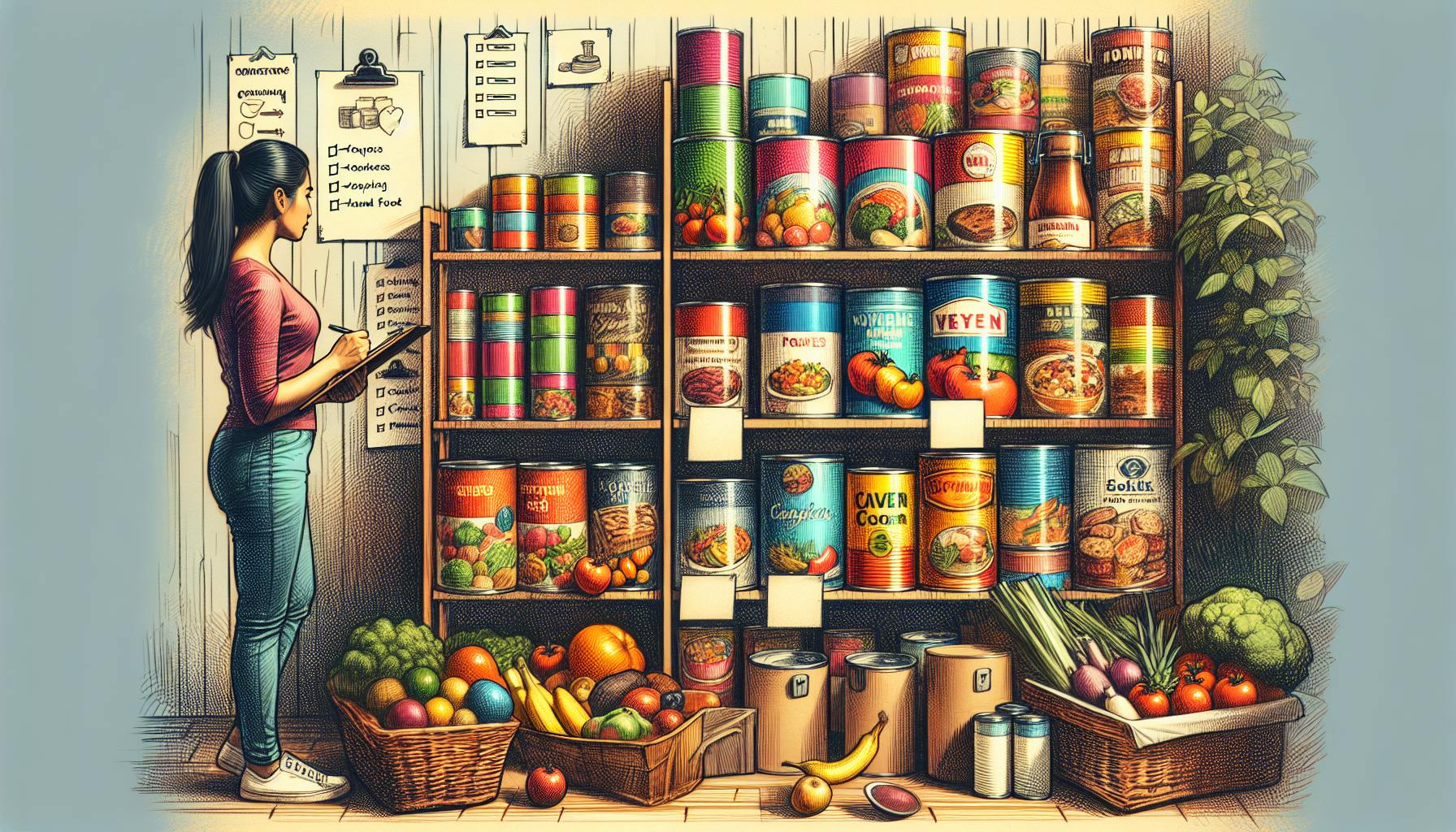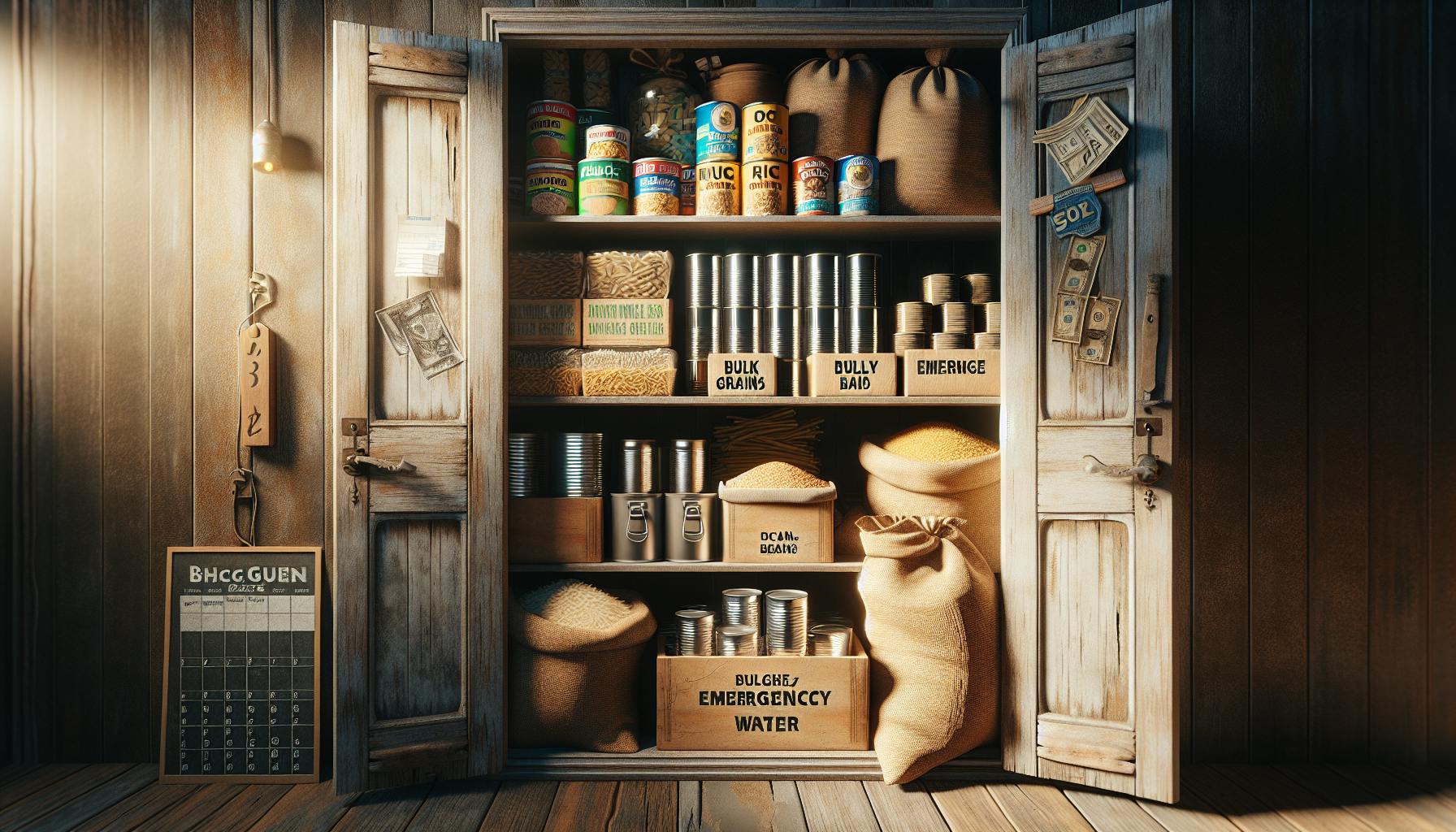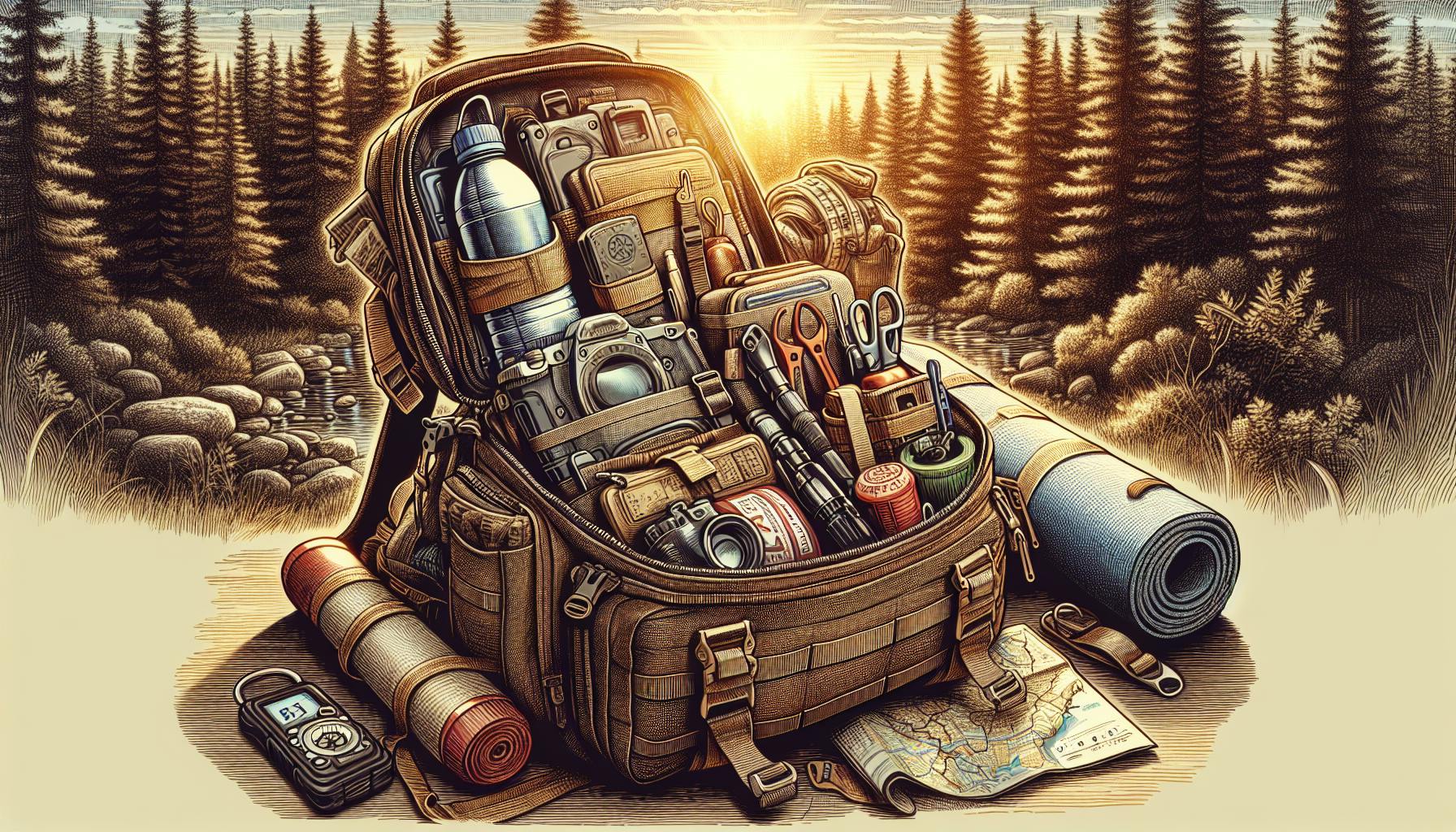When disaster strikes in an urban area, having the right gear can make all the difference.
This guide will provide a comprehensive checklist of must-have items to include in an urban survival bag, ensuring you're fully prepared for emergencies.
We'll explore key categories like sustenance, first aid, self-defense, fire, light, and more - equipping you with the essential knowledge and gear to navigate crisis scenarios in an urban landscape.
Introduction to Urban Survival Bags
Urban survival bags, also known as bug out bags or get home bags, are essential emergency preparedness kits designed for cities and urban environments. They contain gear and supplies to help you safely handle disasters, accidents, infrastructure failures or civil unrest that can occur suddenly when living in a metro area.
Having an urban survival bag prepares you for:
- Natural disasters like earthquakes, floods or severe storms
- Accidents like chemical spills or building collapses
- Infrastructure failures like long-term power outages
- Civil unrest like riots or protests turning dangerous
The key is having the right portable, durable and multi-purpose gear so you can cover your basic survival needs without a lot of bulk.
Defining Urban Survival Bags and Bug Out Bags
Urban survival bags go by different names but serve the same purpose - to help you deal with emergencies in cities:
- Bug out bags refer to grabbing your gear and leaving quickly.
- Get home bags focus more on reaching your home safely.
- Go bags provide bare minimum supplies to survive several days outside.
They all work as emergency kits packed and ready for urban threats. The gear inside focuses on your critical needs - shelter, water, food, first aid, navigation and self-defense.
The Importance of an Emergency Kit in Urban Settings
Urban areas concentrate people, buildings, traffic and technology into complex systems. If something fails, it can cascade into city-wide crises rapidly.
That's why having an urban survival bag is vital:
- No early warnings - Disasters can hit instantly with no chance to prepare.
- Limited resources - High population density strains food, water and medical supplies.
- Gridlock traffic - Roads jam quickly, preventing escape by vehicle.
- Civil disorder - Panic, violence and crime often spike after disasters.
With an urban survival bag, you have gear to handle the first 72 hours no matter what happens.
Creating a Minimalist Bug Out Bag List
Packing light is key for urban survival bags. Overloading a backpack decreases mobility in cities.
Focus on these basics for a minimalist bug out bag:
- Water - Portable filtration/purification for unreliable city water
- Food - Highly caloric, lightweight bars and dried meals
- Shelter - Emergency tent, bivy sack and sleeping bag
- First aid - Trauma kit, medications, tools and PPE
- Navigation - Maps, compass, radio and charging bricks
- Self defense - Pepper spray, alarms and non-lethal weapons
With planning and practice, this foundational urban survival kit prepares you for the worst while staying mobile.
What do you put in a survival go bag?
When preparing an urban survival go bag, having the essential supplies on hand can mean the difference between life and death in an emergency situation. The key is to pack light while covering your basic needs.
Water and Food
Having potable water and non-perishable food is critical. Pack durable, lightweight water bottles and water purification tablets. For food, choose calorie-dense options like protein bars, dried fruits and nuts. These will provide sustenance without taking up much space.
Communication and Navigation
Staying connected and finding your way is vital. Pack a hand-crank NOAA radio, flashlight, spare batteries and a whistle. Having multiple means of signaling for help improves your chances of rescue. A compass and map of the area can assist navigation on foot.
First Aid
Injuries are likely to occur, so a first aid kit is a must. Include bandages, gauze, antibiotic ointment, medical tape, trauma shears, pain relievers and personal medications. Mini first aid guides are available and good to have on hand.
Tools and Self Defense
A good knife, multi-tool, duct tape and fire starter kit equip you to construct shelters, make repairs and start campfires. Pepper spray and alarms can fend off threats. Wear sturdy boots and work gloves to protect extremities.
The key is packing only what you can realistically carry while covering the critical survival bases. Customize based on your specific needs, but travel as light as possible for maximum mobility and safety.
What is an urban bug out bag?
An urban bug out bag, also known as a "go bag" or "get home bag", is a portable kit that contains essential supplies to help you safely evacuate or survive in an urban environment during an emergency.
Unlike wilderness bug out bags designed for remote locations, urban bags are focused on navigating hazards commonly found in cities, like crowds, debris, and lack of immediate shelter or water access. They emphasize lightweight, compact items that address basic urban survival needs for 1-2 people over 72+ hours.
Key supplies in an urban bug out bag may include:
- Bottled water and non-perishable food like protein bars
- Weather-appropriate clothing layers and sturdy shoes/boots
- First aid kit, medications, hygiene items
- Self-defense items like pepper spray
- Tools like pocket knives, duct tape, zip ties
- Emergency shelter such as a tarp, tube tent, or bivvy sack
- Communication devices like hand-crank radios or walkie-talkies
- Fire starters, flashlights, batteries
- Local maps, cash in small denominations
The advantage of an urban survival bag is mobility. With critical gear on hand, you can safely evacuate quickly and sustain yourself until you find reliable shelter or supplies. This allows city dwellers to be proactive during crises vs. dependent on limited emergency services.
An urban bag should blend portability with adequate survival provisions tailored to urban risks. Focus on compact, durable items that address your unique regional climate, personal needs, and potential evacuation routes.
How does survival bag work?
A survival bag, also known as an emergency thermal bag or heat reflective bag, works by using radiant heat technology to retain body heat and maintain a survivable temperature in extreme conditions.
The inside of the bag is lined with a thin sheet of heat reflective material, usually mylar or metalized polyethylene. This material reflects radiated body heat back towards the user, reducing conductive and convective heat loss.
When sealed inside the survival bag, a layer of trapped air helps insulate the body. The bag creates a microclimate around the user, slowing the loss of core body temperature. This allows someone to survive for hours or days longer compared to being exposed to the elements.
Some key benefits of survival bags:
- Retain up to 90% of radiated body heat
- Waterproof and windproof exterior
- Pack extremely small for portability
- Durable construction withstands rough handling
- Can be reused many times
Survival bags have saved countless lives in emergencies. Whether caught in a snowstorm or stranded at sea, the simple technology helps prevent hypothermia and extend survival time until rescue. They are indispensable for outdoor adventurers, mariners, pilots, first responders, and anyone facing hazardous environments.
sbb-itb-b932644
What is a doomsday bag called?
An urban survival bag, also known as a bug-out bag (BOB), get out of Dodge (GOOD) bag, or 72-hour kit, is a portable emergency kit filled with gear to help you survive for 3 days if disaster strikes while you're in an urban area. These bags are designed specifically for evacuation and survival in a city setting.
Essential items in an urban survival bag include:
-
Water and food rations - Pack high-calorie, non-perishable food like protein bars, nuts, and dried fruits. Have at least 1 gallon of water per person per day. Water purification tablets are a compact way to make found water drinkable.
-
First aid supplies - Include bandages, gauze, medications, etc. to treat injuries. A first aid handbook is also useful.
-
Navigation tools - Have a map of the city plus a compass and GPS device to find your way if normal navigation infrastructure fails.
-
Light sources - Pack a flashlight, glow sticks, and headlamp with extra batteries. Being able to see at night is crucial.
-
Self-defense items - Pepper spray, a tactical pen, or other non-lethal weapons can help you defend yourself if needed.
-
Shelter and warmth - A mylar blanket, hand warmers, and rain poncho will protect you from the elements.
-
Communication devices - A radio, walkie talkies, or satellite phone lets you get news, call for help, or locate separated people.
Customize your exact gear depending on your needs, local laws, climate, etc. The key is having versatile equipment to handle diverse emergency scenarios. Regularly inspect and refresh your supplies as well.
With the right urban survival bag, you can evacuate cities safely during disasters and meet basic needs until you find permanent shelter again.
Urban Survival Bag Essentials: The Ultimate Checklist
Must-have equipment to include in your bag for handling urban emergencies.
Water and Food: Sustenance on the Go
Having potable water and non-perishable food helps maintain energy and health when immediate resources are disrupted. Useful items include:
- Water purification tablets to make found water drinkable
- Collapsible water bottles and pouches to carry and store water
- High-calorie protein bars and dried fruits as compact nutrition
- Electrolyte powders to replenish salts and minerals lost from sweat
Rotating and replacing food and water supplies every 6-12 months ensures freshness.
BOB First Aid Kit: Your Lifeline in Emergencies
A robust first aid kit provides lifesaving treatment for injuries until professional medical care is available. Essentials include:
- Adhesive bandages, gauze, trauma pads, butterfly bandages for wound care
- Antibiotic and anti-itch ointments to prevent infection
- Medical tape, tourniquet, tweezers, trauma shears, safety pins
- Medications like ibuprofen, antihistamines, antacids, anti-diarrhea
- N95 respirator masks to filter airborne particles
Replenishing first aid supplies and medications before their expiration ensures readiness when needed most.
Non-Lethal Self-Defense Items for Urban Survival
Non-lethal self-defense gear like pepper spray enables personal safety when law enforcement presence is diminished. Helpful items include:
- Pepper spray for fending off human attackers
- Tactical flashlight with strobe feature to disorient threats
- Steel tactical pen for self-defense if needed
- Emergency personal alarm to scare away attackers
- Leatherman multi-tool with knife as last resort
Practicing proper use of self-defense gear develops muscle memory and confidence during stressful situations.
Fire Starting Tools: Igniting Hope in Crisis
Equipment like weatherproof matches, lighters, and fire starters facilitate warmth and cooking in austere conditions. Key fire starting gear consists of:
- Windproof/waterproof matches and stormproof lighters
- Magnesium alloy fire starter to generate sparks
- Tinder materials like dryer lint, wax-soaked cotton balls
- Emergency candle and solid fuel tablets
Storing fire starting equipment in waterproof containers keeps it operational in damp conditions.
Light Sources: Illuminating Your Path to Safety
LED flashlights, glow sticks, and headlamps provide hands-free illumination in emergencies occurring at night or in dark locations. Helpful light sources include:
- Small LED flashlight for portability and runtime
- Headlamp allowing hands-free task lighting
- Glow sticks as backup lighting without batteries
- Extra batteries to power flashlight/headlamp
Strategic use of light sources preserves battery life, while signaling features on some flashlights can indicate position to rescuers.
Tactical Skills for Urban Survival
Beyond gear, cultivating operational skills helps you make effective use of what's in your bag. Developing proficiency in key areas builds confidence to handle emergencies.
Mastering Urban Navigation Techniques
Using maps, compasses, and grid references enables successfully reaching secure locations when normal travel is disrupted. Study maps to identify landmarks, routes, and potential shelter locations. Practice navigation skills regularly to commit techniques to memory.
Emergency Communication with 2-Way Radios
Proficiency with two-way radios, emergency texting apps, and other alternate communication methods helps coordinate with others. Research reliable two-way radio models and apps. Learn proper radio protocols and texting abbreviations to quickly share information. Conduct communication drills to ensure readiness.
Water Purification: Ensuring Safe Hydration
Applying water purification tabs, filters, and boiling allows utilizing available water sources for drinking. Obtain purification supplies like tabs, straw filters, and metal containers. Study correct usage and dosage. Boil water for 3-5 minutes to kill bacteria. Verify water purity before drinking.
Administering First Aid in Urban Disasters
Knowing how to treat cuts, burns, sprains, and other common injuries assists others until professional medical response is possible. Assemble first aid kits with essentials like bandages, ointments, scissors, and gloves. Take first aid and CPR courses to properly apply lifesaving skills.
Resourcefulness: Foraging and Scavenging in the City
Identifying edible plants, hunting small game, and scavenging usable materials supports self-reliance in prolonged emergencies. Research common urban edible plants like dandelions, clovers, wood sorrel. Learn trapping techniques for squirrels, rabbits. Locate possible scavenging sites like abandoned buildings, construction sites. Regularly practice skills.
Supplementary Urban Survival Gear for Enhanced Preparedness
While not absolutely critical, useful items that improve resilience across urban emergency scenarios.
Emergency Shelter: Your Haven in Urban Chaos
Having a portable shelter like a tent or bivy sack can provide critical protection when seeking refuge during an urban emergency. A lightweight, compact shelter takes up little space in your bag but offers respite from the elements if you are unable to reach an established shelter location.
Consider a small 1-2 person backpacking tent or bivy shelter made from durable, waterproof materials. Opt for neutral colored shelters over bright colors to remain discreet. Practice setting up your portable shelter at home so you can quickly erect it if needed during a crisis.
Respirator Masks: Breathing Safely Amidst Urban Threats
Respirator masks protect your airway from smoke inhalation and airborne viruses when evacuation from an urban emergency is not immediately feasible. N95 and N100 masks filter out 95% and 99.97% of airborne particles respectively.
Select a compact, folding respirator mask that fits your face properly. Consider a small pack of N95 masks or a reusable elastomeric respirator with P100 filters for the best protection. Practice wearing your mask to ensure good fit and comfort if worn for extended periods.
The Versatility of a Multi-tool in Urban Survival
A good multi-tool like a Leatherman enables repair, cutting, prying, and manipulation tasks using several integrated tools in one compact, portable package - valuable during urban disasters.
Seeking shelter, harvesting materials, repairing gear, and even self-defense are just some critical uses for a multi-tool when urban infrastructure fails. Choose one with pliers, knives, screwdrivers, bottle opener, saw, etc. based on your needs. Rugged, stainless steel multi-tools withstand heavy use.
Financial Preparedness: Carrying Cash in Small Bills
Cash ensures you can still procure critical goods or services during infrastructure disruptions that render electronic payments unusable. Carrying small bills - $5, $10, $20 - allows flexibility to transact for items of varying costs versus large bills.
Keep at least $100-200 in small bills sealed in a waterproof case or bag within your urban survival kit. Include some coins to cover exact change as well. Rotate this cash supply every 6-12 months to keep bills crisp and usable.
Radiation Safety with Potassium Iodide Tablets
Potassium iodide tablets taken at onset of nuclear emergency saturate thyroid gland iodine uptake to block absorption of radioactive iodine particles released. This protects against radiation-induced thyroid cancer.
Standard dosage is 130mg tablets for adults; children receive proportionally smaller doses based on weight. Research proper dosing; take only when directed by health officials during nuclear events. Replace expired tablets annually. Consider adding KI tablets to your survival kit if in a major city.
Finalizing and Maintaining Your Urban Survival Bag
Once packed, be sure to regularly inspect and update your bag to keep it preparedness mission ready.
Choosing a Tactical Bug Out Bag for Durability
When selecting a bug out bag, durability is key. Look for bags made from rugged materials like 1000D nylon or Cordura fabric, which can withstand harsh weather and heavy use. Features like YKK zippers, padded straps, and MOLLE webbing for attaching additional pouches also improve durability.
A tactical or military-style backpack optimized for survival gear is ideal. Consider bags from 5.11 Tactical, Direct Action, REEBOW GEAR, and other top brands designed for rugged reliability.
Routine Inspection: Keeping Your Urban Bug Out Bag List Updated
At least once per year, thoroughly inspect your urban survival bag. Check expiration dates on any food, medicine, batteries, tools, or other perishable items. Replace anything expired or close to expiration.
Also verify the right sizes and seasons of any clothing items in your bag. Children especially grow quickly. Ensure you have weather-appropriate layers.
Reassess all gear, removing unused items and upgrading tools that now have better options. Update your bug out bag checklist accordingly.
Testing and Upgrading Your Survival Gear
The best way to test preparedness is to utilize your equipment and skills. Schedule practice hikes using only your bug out bag for a self-supported camping trip. Identify any lacking or non-functional gear through real-world experience.
As innovative new survival tools emerge, upgrade older items in your bag. For example, upgrade to a solar powered battery pack, high lumen tactical flashlight with multiple modes, paracord with embedded tools, or a more compact portable water filter.
Staying current ensures you have the best urban survival gear money can buy in your go bag. But nothing beats hands-on testing for true preparedness.


